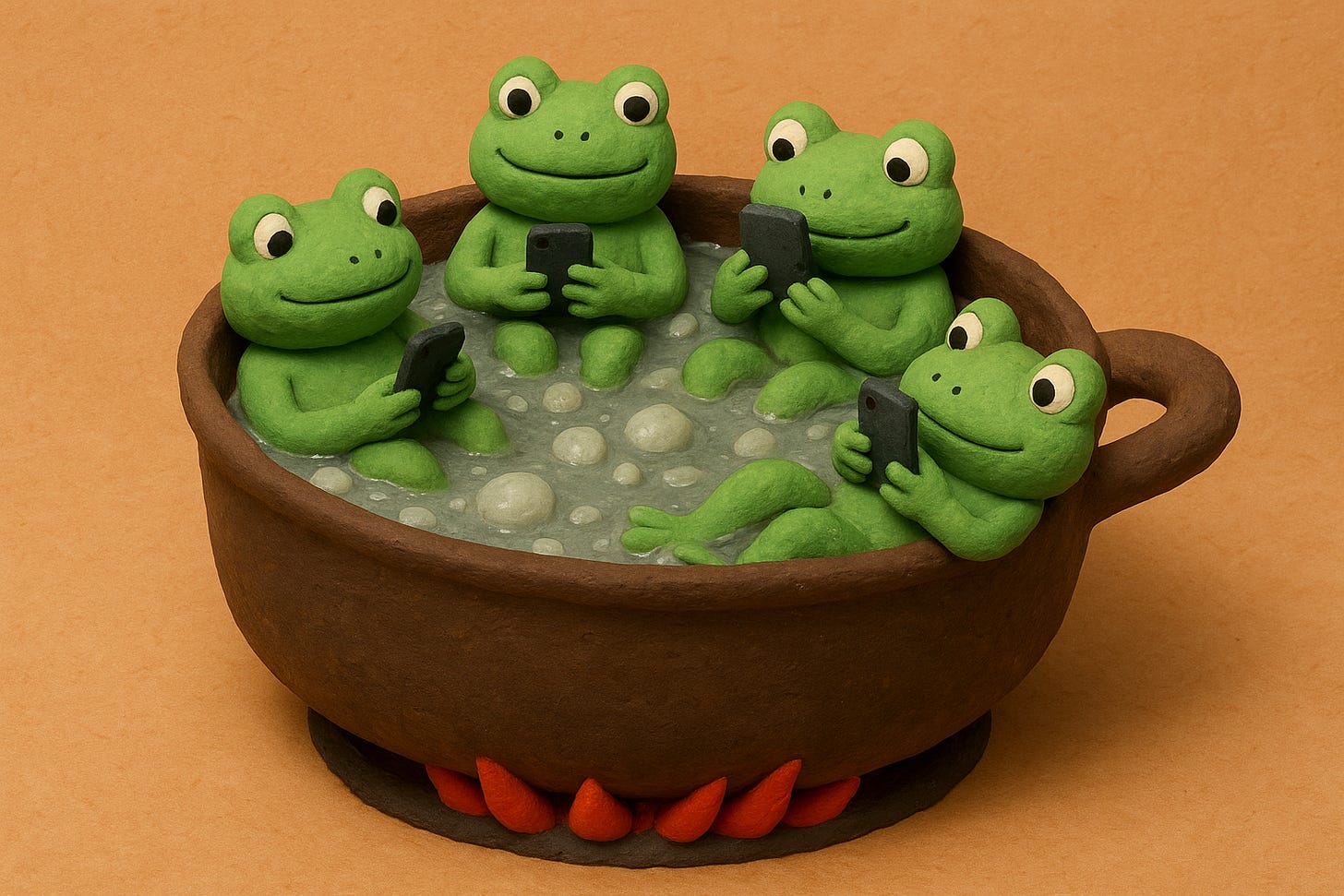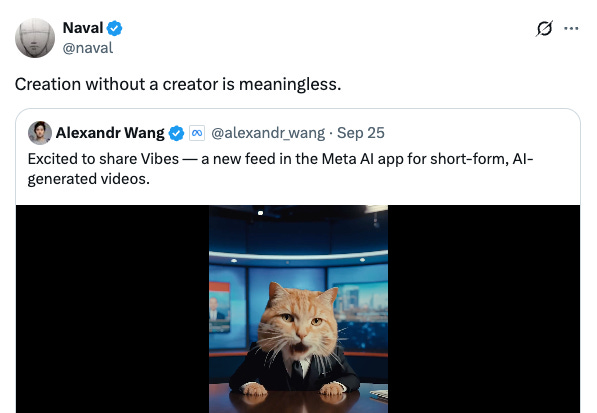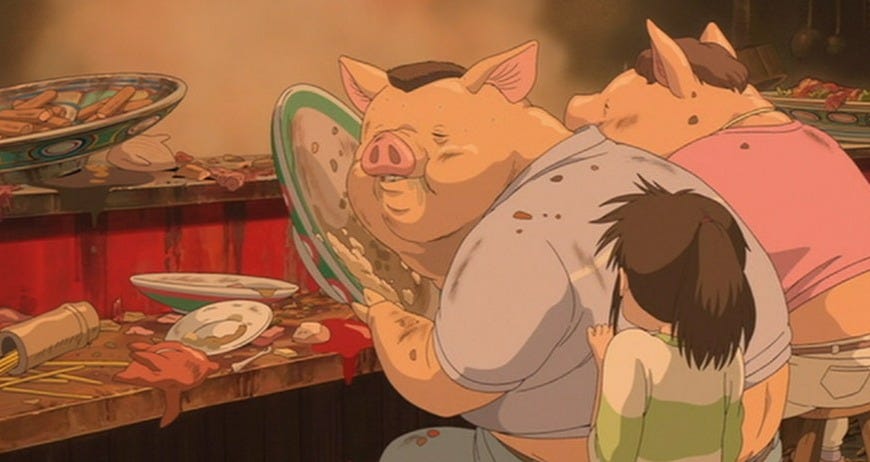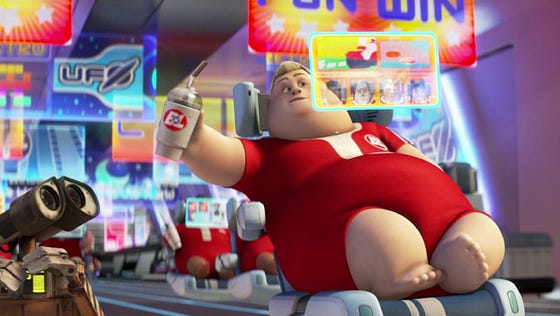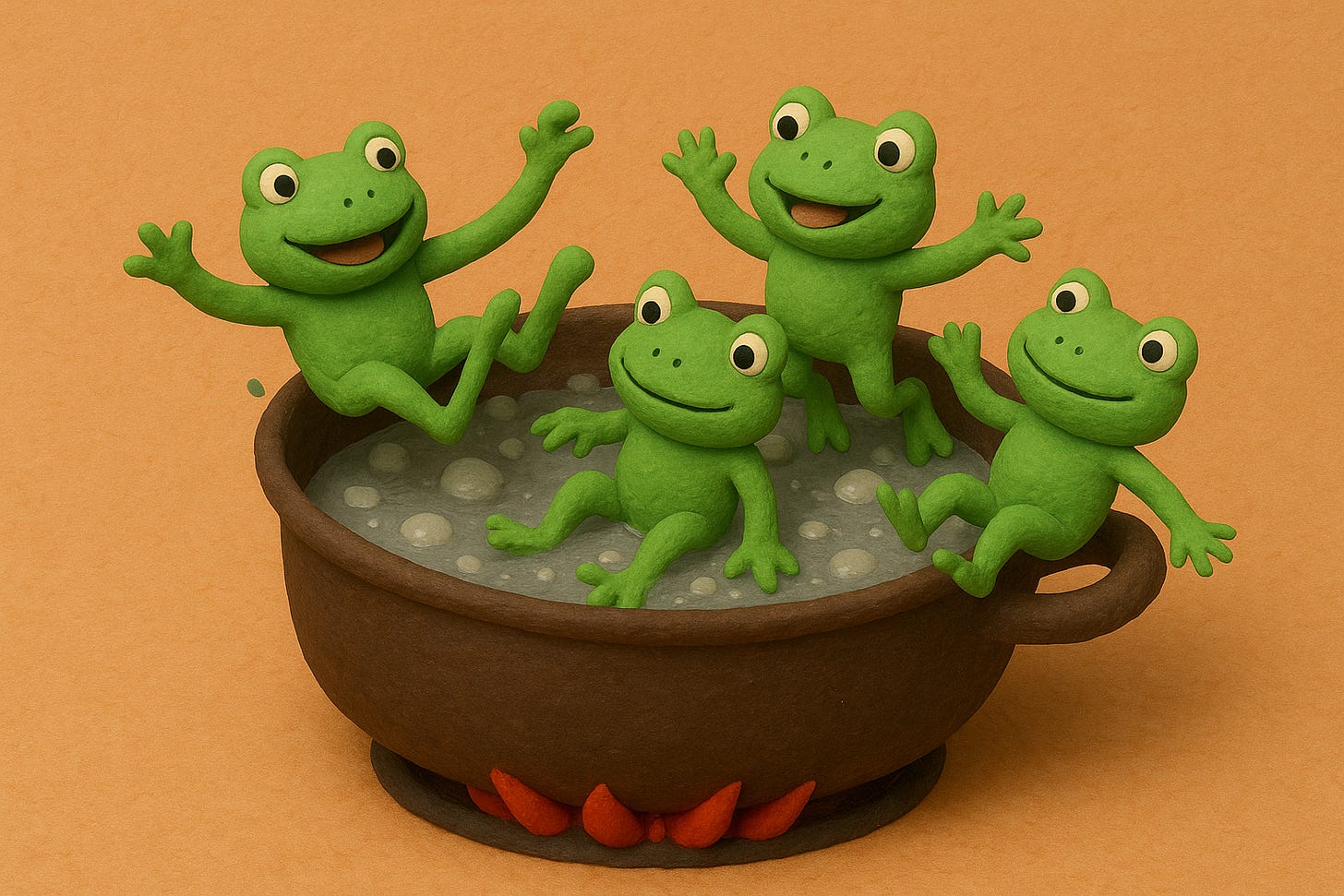We're Boiling Frogs in AI Slop
The dilution of quality on the Internet and our growing tolerance for it.
Call it what you want: Brain Rot. AI Slop. Doom Scrolling. Meta Vibes. Sora 2.
Over the past few weeks, two major product announcements have captured the zeitgeist on Twitter/X. Together, they have been raising all sorts of red flags about what online consumption and the future of the Internet will look like.
Meta Announces Vibes
Three weeks ago, Meta announced Vibes — a platform that could be summarized as TikTok but exclusively filled with AI-generated videos. The quick backlash brought up comparisons to the humans in Wall-E, immobile and endlessly staring into screens.
A highly regarded Internet voice in tech, Naval, retweeted the Vibes launch post with the addition that “Creation without a creator is meaningless.”
It’s a very succinct point. People are deeply social, and social interactions are linked to our brain chemistry. Stripping the human element from content removes the emotional effects of finding connection and being recognized. Essentially, all that’s left is dopamine. There’s a lot to miss.
OpenAI Launches Sora 2
Then, two weeks ago, OpenAI released Sora 2: a new video generation AI model along with a companion mobile app. Another TikTok competitor. It was received with a mix of technical praise and criticisms: “We were promised a cure for cancer and we got more short form video content.”
The initial reaction has been warmer than I might’ve guessed. A big part comes from the impressive video generation technology and a gimmick of placing yourself (and potentially your friends) in videos. Will it retain users as the novelty wears off?
TikTok, but make it… worse.
It doesn’t take much mental energy to see what direction tech giants are moving in. We’re headed toward a world where content is easier to create, the line between fake and real is blurred, and engagement is the goal of every platform. The videos might be flashier but they push further and further from reality.
That’s not a world anyone should be excited to live in.
Why are these so “bad” if they entertain us?
Consider all the various things you could spend your leisure time doing. Going for a walk. Listening to music. Hanging out with friends. Staring at the wall for an hour. These AI video platforms employ the worst of each.
AI “slop” and much of short form video content is particularly bad because of the level of stimulation. A constant buzz on your attention. Infinite reels to refresh. Anxiously awaiting a “good” one. Sucking away just enough of your focus to turn seconds into minutes. It’s akin to empty calories in a diet. You might find yourself captivated by a short, animated video, but there’s no sense of lingering satisfaction. Unlike enjoying a rich story or great meal, it’s on to the next one. Next, next, next, next, next. Maybe you’ll find something “valuable” to send your friends eventually.
…Not to mention, the act of staring at a tiny screen 12” away from your face can’t be helping your eye health or your posture.
But what SHOULD we be doing with our free time?
Why are other activities, like the cherished “go for a walk,” any better for you? Because people need something that creates space to process, to pull themselves out of the fog, to escape the addicting search for something valuable: a hunt that never ends.
Consider some activities that keep you busy but not quite so stimulated. Gardening, running, working out, knitting, even reading can give your brain and body something to do without the dopamine-heavy interactions that comes from our devices. Try some little hobby for 30 minutes instead of scrolling, and the difference in your mental state afterwards will be night and day.
The Great Dilution of Internet Content
One of the greatest things about the Internet is the sheer volume of things. Interesting things. Weird things. Awful things. Unique and amazing things. As a user of search, social media, and now AI, you’re able to explore the sea of things. Finding something worthy of sharing is like discovering a tiny treasure.
Short form video content is an easy target in the fight for quality, but there has already been a widespread decline in the degree of quality we find while scrolling, tapping, and staring at our little screens. It all started long before the “slop.”
Facebook ads mixed in with content when they launched the newsfeed. Newsfeed “ad load” has been estimated to be as low as 3% in 2015 and now is generally measured at or above 20%. This pattern holds across most platforms.
“For you” algorithms were created to start showing you the “most interesting” content. The stuff you’ll engage with the most. Mindless engagement leads us away from meaningful content and increases our time in the apps.
Even the content our friends post on social media has shifted. It’s largely become a way of showing status, “look how great my life is” and the real stuff is saved for private chats. Beauty filters run amok.
This dilution of good content has been steady and gradual for over a decade now. We might blame capitalization and public company demands. The Internet is full of opportunities to make money, and so far, no one scrolling seems to care (enough) about how much of their time, attention, and cash is squeezed out of them.
It’s beginning to feel like we’re a bunch of frogs in a pot, slowly heating up until it boils and we meet our demise.
We were promised flying cars and all we got was Short Form Video Content.
That Wall-E future? We’re already there. Look around a busy train or subway car. Most people are hunched over, staring at their phones. These aren’t urgent messages. The majority are watching short form video content.
How did we get here? It’s all a story of incentives and optimizations.
Most of the apps we use are ad-based: the platforms are incentivized by the advertisers. They make money when more people click on their ads and buy their things. This leads platforms to gradually saturate with ads, optimizing for what we can tolerate.
It’s not just more ads per scroll; these platforms optimize everything to generate more money for their advertisers (and themselves in the process). This ultimately means more people spending more time in the apps and clicking on more ads.
Platforms discover that influencers and now AI are more “interesting” than your friends and family. They live a wider range of experiences, are experts at creating content, and have the time to create engaging videos. Focus shifts from friends pics to influencer photos to highly-produced videos.
The platforms become an economy. Influencers at all levels realize how much money can be made. Beyond traditional ads, they seek product placements and partner deals. Half of what we see becomes sponsored and early creators chase trends to grow their followings and land a deal. Brands wonder if they can save money using AI-generated influencers. Will their audience care?
In the end, your connection to you friends dilutes. They are still on the platforms, rarely posting, but watching the same videos as you, occasionally sharing. Interactions devolve into reacting to posts of fun looking pastries in a city you don’t even live in.
Even our phones are getting bigger and bigger. I desperately miss my iPhone 13 Mini but it’s unlikely that size will ever return. If people primarily use their phones to watch videos, then phones will grow to look more like TV screens than utility devices.
Escaping the Boiling Pot
So, if we are all metaphorical frogs in a pot of warm water, approaching a lethal temperature, how do we convince ourselves to leap out? How do we reach consensus: “This is hot. This is getting worse. Let’s leave.”
Consensus hasn’t yet reached a point where government intervention or the major tech companies themselves would moderate the tools generating endless slop. Someday that might be the most effective way to create change — you might imagine a law to create “non-slopping” sections in restaurants like the early days anti-smoking? You can stare at your little device only in this section. Enjoy the brain rot!
For now, we need attractive alternatives.
Throwing the baby (frogs) out with the (boiling) bath water
As companies charge toward the “infinite slop” never-ending attention future, they often abandon their old principles. I’ve heard reports that Instagram is even considering moving Reels to their main screen.
Think of something as simple as birthdays. These used to be a huge value-add from Facebook. People would send “Happy Birthday!” to appropriate friends daily. Logging into Facebook was actually fun on your birthday. “Look at all these people that love me!”
I’m sure some people still use Facebook birthdays, but most millennials and Gen Zs have left the platform in favor of Instagram and group chats. Birthdays have been thrown out with the bath water — becoming again something to be remembered or added to your Google Calendar as annual events.
Open Spaces
With the once-supreme birthday feature of Facebook now neglected, niche apps have popped up to take its place. Some have become so sophisticated that they can even auto-populate birthdates simply by looking at your contacts. (Don’t ask me how…)
It’s not just birthdays. When big tech goes to chase the new shiny (sloppy) things, spaces are created in the wake of their migration. This is a huge opportunity for founders (myself included) and a chance to repair the damage left behind. People still want meaningful experiences and content from their real friends.
Filling the Void
One major benefit of AI is that it’s getting easier than ever to grow and start companies. Though this attracts plenty of “get rich fast” founders and products that might be considered “slop” themselves, it also enables the ambitious altruists and idealists to create their ideas.
There are people working to improve our relationships with our devices. A few examples:
Bringing back peace: Apps like Opal turn screen time tracking into a fun experience, and Apple’s own Screen Time controls is incredible useful for limiting apps or groups of apps. I haven’t tried it yet but I’ve heard Brick is even more effective — a physical device to lock yourself out of unhealthy apps.
Purpose-built devices: Few receive rave reviews, but I love to see all the new hardware companies popping up. It’s healthy to challenge the idea that we need to carry a smart phone at all times. The Light Phone 3 is one of the more elegant devices in this space. I’m also excited about smaller folding phones and even Meta Glasses in their current state (before they get overloaded with notifications and add short form video content to the display).
More intentional apps: Apps can work to directly foster the positive interactions now rare in social media, like Happyfeed. Designed to be a place for positive memories, it’s evolved into a private Instagram alternative. A place to share photos and videos only with the people you care about. No ads, influencers, or AI slop. As the social media giants move into new spaces, I’ve been pleasantly surprised how large the space left for my little app has become.
Final Note: AI isn’t inherently Bad.
You might think that I’m suggesting that AI is directly, globally causing the rotting our brains. And well… in many ways, maybe it is — in the same way that Google Maps “rotted” our ability to drive anywhere without a blue line to lead the way. In the same way that the printing press “rotted” our ability to remember and tell long epics like The Iliad.
With advancement comes replacement, and that’s expected. It’s part of progress and we should embrace it when it leads to better lives.
What is bad is when we leverage these tools for the sole purpose of driving up the stock price of companies at the expense of the consumer. Doing things that are unquestionably worse for people because it leads to longer sessions, more taps on ads, and more money shifting from pockets to coffers.
The incentives need to change.
One of the first steps is awareness. So here I am, raising a little red flag. 🚩


